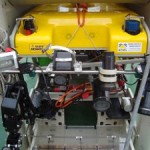
You have to respect The Nature Conservancy (TNC) because they put their money where there mouth is. While some other organizations have a tendency to turn “conservation” into “conversation”, TNC has a tendency to purchase property and throw up a no trespassing sign. Sure, it gets them into trouble sometimes, but privatizing a resource is a great way to avoid the Tragedy of the Commons. Eventually, these properties are absorbed into state of federal park lands, often in better shape than they would have been otherwise.
But what to do about the oceans? In some states, submerged lands in bays and estuaries can be leased for shellfish mariculture, but in general, you can’t buy up plots of oceans and place them off limits to surfers, scuba divers, and fishermen. There are exceptions, of course, but for better or worse, the oceans are for the commons. So, TNC will need to find new ways to do business in the sea.
They have excellent leadership in the marine realm from Rod Salm, who literally wrote the book on Marine Protected Areas, and Mike Beck, who’s done a lot of work here in the Gulf of Mexico. TNC is now announcing a great set of new coral reef intiatives, including the 20 million dollar Caribbean Challenge. Finally, an international coral reef initiative is happening close to home, in the West Atlantic.
My contribution to the effort is pasted above, a 3D view of the Caribbean Sea by Bruce Heezen and Marie Tharpe from Wust 1964 showing just how deep is our love for the Caribbean. That’s alot of submerged habitat. The Cayman Trench is in the upper left between Jamaica and the Cayman Islands. It extends from the Windward Passage at the southeastern tip of Cuba toward Guatemala. The relatively narrow trough has a maximum depth of 7,686 m. And its corals all the way down… Good luck, TNC. We’re with you.
References:
Wust, G. (1964): Stratification and circulation in the Antillean-Caribbean Basins. Pat. I. Spreading and mixing of the water types, NY Columbia University Press 201 p.






In other words, The Nature Conservancy uses money acquired primarily from public sources to acquire land by bullying landowners. Then they remove from the tax base of a community, causing financial difficulty to the local community and schools. Then TNC blackmails state and federal government by decling public use of the acquired property until we ante up public money to buy the property back at an inflated price.
This is an international scandal conducted in the name of conservation. The Nature Conservancy is the world’s largest and richest land broker using the imige it cultivates as a “do gooder” to divert public atention from its multi-bllion dollar real estate machine. See The Nature Cnservancy Scandal blog at http://tncscandals.blogspot.com/ for many more expamples.
Every organization has a scandal, Harley. Like I said, the landowner approach gets them into trouble. Not all the money at TNC comes from taxes and subsidies, though. Some resources come from land grants and donations by people who believe in the organizations mission and goals.
I am trying to guess whether you’re a landowner who lost your rights because an endangered species was found on your property, (was it prarie dogs?) or a disgruntled ex-employee who’s making it your life’s work to discredit the organization. C’mon, Harley, which is it?
Probably neither, Peter, but your shaping of the question does reveal how deeply your mind has been colonized.
Not to worry. Once the needle goes in, it never comes out.